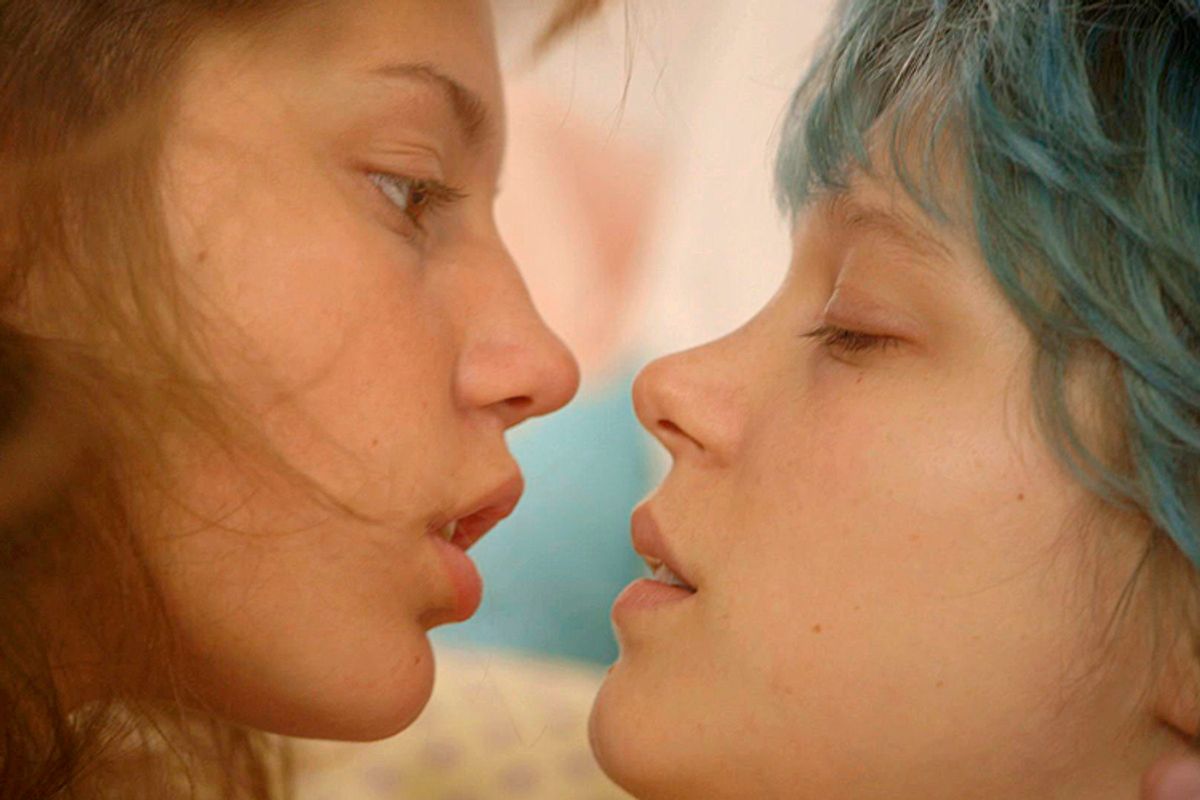CANNES, France – Now that the sun has emerged and the promiscuous, unreasonable colors of Mediterranean spring have replaced dingy, drizzly gray, conversations at Cannes have turned to this year’s other big topic: What kind of movie is a Palme d’Or jury headed by Steven Spielberg going to like best? You can certainly make a case for Japanese director Hirokazu Kore-eda’s heartwarming family drama “Life Father, Like Son,” the most Spielbergian of competition entries. But whatever you make of his own films, Spielberg is a genuine cinephile; I can just as easily imagine him being swept away by the Coen brothers’ "Inside Llewyn Davis,” Asghar Farhadi’s “The Past” or James Gray’s magnificent, old-fashioned “The Immigrant” (review coming soon!), just to name a few.
But we suddenly have a favorite in the Palme d’Or race. (Which is a long way from having a winner, to be sure.) “Blue Is the Warmest Color” is an intimate and spellbinding drama from the French director Abdellatif Kechiche, which follows a teenage girl named Adèle (fast-rising French actress Adèle Exarchopoulos, on screen in almost every shot) through sexual maturity and early womanhood, focusing on the first great sexual and romantic passion of her life. (The French title translates as “The Life of Adèle, Parts 1 & 2,” while the English title refers to the original source material, a graphic novel by Julie Maroh.) That this love affair happens to be with another young woman, a slightly older lesbian with dyed blue hair named Emma (played with wonderful confidence by the tremendous Léa Seydoux), both is and is not important. It’s not clear that Adèle ever conceives of herself as gay, and indeed she may not be; her other affairs seem to be with guys. “Love has no gender,” someone tells her in a gay bar, the first time she ever visits one. “Love whoever loves you. Man, woman – what does it matter?” As Adèle will find out in due course, you can wind up being the one who washes the dishes in any genre of relationship.
There’s no question that this intense and remarkable film (which is almost three hours long but never lags), shot largely in closeup and focused on the combustible performances of its remarkable young stars, will take France by storm. Set in the unpretentious provincial city of Lille, it depicts the social and political anxieties of France's most diverse and multicultural generation of young adults, where Arab pop music, anti-austerity demonstrations and gay pride marches go hand in hand. If Kechiche has been largely identified up to now with movies about the Arab-French minority (like the wonderfully rich “Secret of the Grain”), this one could be viewed as his declaration of patriotism, his embrace of contemporary France in all its multiplicity and difficulty. Indeed, for a male filmmaker from an Arab background to make a film that contains numerous scenes of steamy and highly explicit lesbian sex is itself a political statement.
Now, it’s perfectly true that French films contain more casual nudity and unadorned sexuality than their American counterparts; it’s a point of national pride. But even by French standards, “Blue Is the Warmest Color” is pretty doggone racy. There are several extended scenes of Emma and Adèle going at it in athletic and indeed gymnastic fashion that leave nothing to the imagination, and that blur any possible boundaries between simulated movie-sex and the real thing. It was remarkable to hear how deadly quiet a packed audience of 800 or so critics can get! I believe there were a handful of walkouts as the first sex scene stretched out to five, six and seven minutes, but quite honestly it was hard to take my eyes off the screen. (We can have the discussion about whether this is a voyeuristic "male gaze" movie, but let's not have it right now.) Reviews in Variety and the Hollywood Reporter have already suggested that the movie needs to be edited down for American release. Optimistically, there are around 100 or so theaters in the United States that can show an unrated three-hour-long French film that features hot lesbian sex between characters who appear to hover right around the age of consent. (Adèle is supposed to be 16 or 17 when she first sleeps with Emma; the actress Exarchopoulos is now 19.)
But that 100 theaters may be more than is necessary. Arguably, this is precisely the kind of movie for which VOD was invented. Since IFC/Sundance Selects will distribute the film in the U.S., interested viewers from Manhattan to Mississippi will be able to watch it at home. That’s terrific as far as it goes, but “Blue Is the Warmest Color” is not just, or even primarily, a hot lesbian-sex drama. It’s a vivid and vibrant film, alive with color and characters and life, which is both social and personal, universal and specific. (The cinematography, which is straightforward but highly effective, is by Sofian El Fani.) It’s only incidentally about the question of sexual identity, and far more about being young and falling in love and screwing it up and having your heart broken in a country and a world that’s changing with bewildering speed. It’s perhaps the first great love story of the 21st century that feels completely of the moment. Does Steven Spielberg agree? We shall see.



Shares